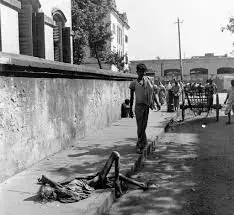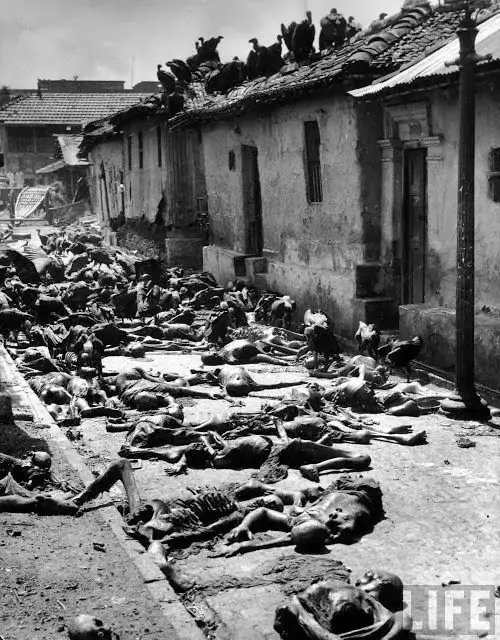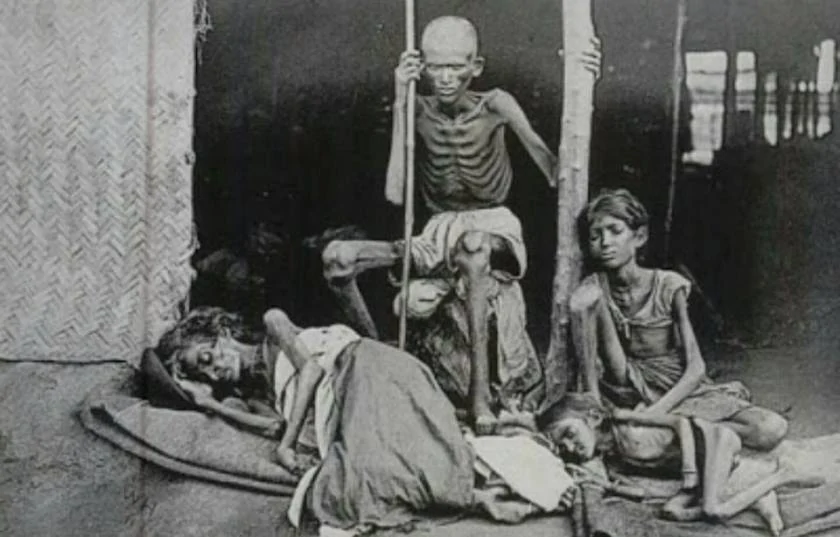El 22 de agosto de 1943, emergieron las primeras imágenes del genocidio en Bengala, revelando una de las tragedias más horripilantes cometidas por la mano del Imperio Británico durante la Segunda Guerra Mundial.
La Hambruna de Bengala borró del mapa a más de 3 millones de seres humanos y es innegable que detrás de la fachada de la grandeza británica hubo un estruendoso eco de crueldad y deshumanización, dejando morir de hambre a los indios para continuar enviando comida a los soldados del imperio.

Antes del estallido de la guerra, Bengala ya sufría las repercusiones de la Crisis Económica de 1929, que dejó a la región en un estado de fragilidad que, lamentablemente, se vería amplificado por las circunstancias bélicas. Con el lanzamiento de la guerra en 1939, Gran Bretaña optó por transformar la economía bengalí en una mera herramienta para la guerra, sacrificando las necesidades básicas de la población en favor de sus fuerzas armadas.
El giro trágico comenzó en 1942, un año fatídico en el que no solo la guerra europea se intensificó, sino que Japón asestó un golpe devastador al Reino Unido, arrebatando la colonia de Birmania. Esta catástrofe supondría la pérdida del 15% del grano destinado a la India, generando una escasez crítica de alimentos en una región que ya estaba al borde del abismo. Agregándose un ciclón devastador en octubre de ese mismo año, que arrasó las tierras de cultivo, llevando a miles de familias a la peores penurias.

Mientras la mortalidad se disparaba, el gobierno británico se mantenía ciego ante la calamidad. Con un desdén abominable hacia la vida de millones, decidieron continuar desviando recursos alimentarios para satisfacer las necesidades de sus tropas en el frente oriental, dejando a las comunidades bengalíes totalmente desprovistas de alimento.
La sangre de aquellos que sucumbieron por inanición, enfermedades o disparos de soldados británicos mientras saqueaban por comida, pesa sobre las manos de una administración que antepuso su propio interés a la humanidad.

La administración británica, con figuras como Winston Churchill al frente, fraguó una política que no solo ignoraba, sino que marginaba deliberadamente la vida de millones de indios. En una de sus muchas atrocidades, Churchill descalificó a la población de Bengala, reflejando un desprecio tan profundo que su administración se dedicó a encarcelar y reprimir a quienes se atrevían a protestar contra esta devastadora injusticia.
Cientos de miles de familias se vieron forzadas a tomar decisiones inimaginables; se sacrificó a los más vulnerables, se vendieron a hijos e hijas, y la desesperación se extendió como una sombra ominosa sobre las calles de Calcuta y otras ciudades.
La hambruna fue tan completa que los cuerpos sin vida se acumularon, superando la capacidad de cualquier servicio funerario, alimentando aún más la propagación de enfermedades horrendas.

Los testimonios de aquellos días fueron finalmente traídos a la luz por el valiente trabajo de reporteros y fotógrafos como Ian Stephens, quien, con su lente, capturó la agonía de un pueblo en ruinas.
Sin embargo, la reacción británica fue angosta y mezquina, intentando más bien encubrir la situación que aliviarla, perpetuando la narrativa del imperialismo amable que jamás existió.
La Hambruna de Bengala es un recordatorio crucial de las atrocidades del imperialismo británico y es imperativo que esta oscura historia no caiga en el olvido.
Las imágenes de la tragedia, que emergieron el 22 de agosto, no solo exponen una negligencia criminal; también son un grito que nos urge a desafiar la narrativa simplista que oscurece la brutalidad del colonialismo británico.






